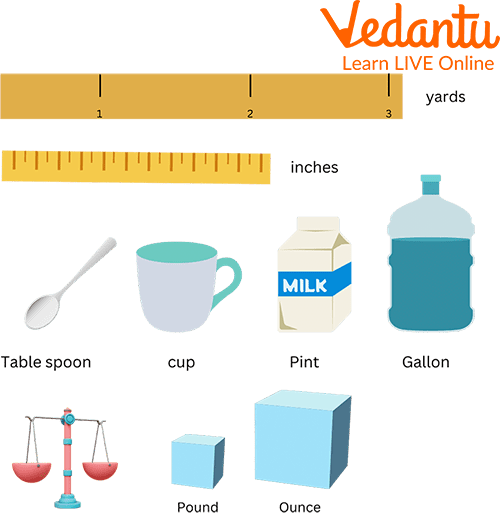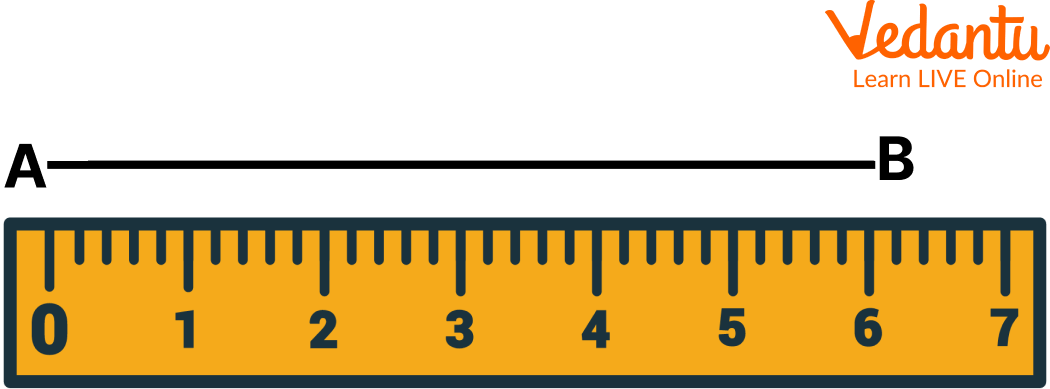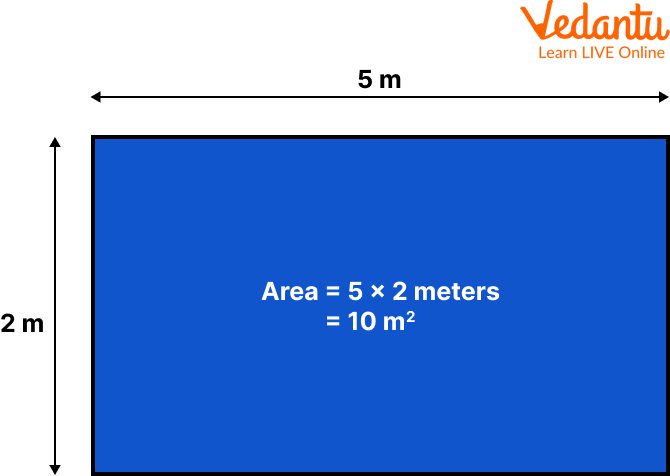




Essential Formulas and Real-Life Applications of Length, Area, and Capacity
Measurement is finding the number which shows the size or amount of something. It can also be described as a technique through which the properties of an object are determined to a standard quantity. It is also referred to as the process or result of determining the magnitude of quantity such as length or mass, relative to a unit of measurement, such as meter or kilogram.

Varieties of Measuring Units.
The units of measurement are the collection of standard and other units that are used to measure various physical quantities. It is a tool to measure and compare different things. Comparison becomes easy when all the units for the measurement are the same.
Definition of Unit in Maths
Units are the tools to measure and compare different things. Comparison becomes easy when all the units for the measurement are the same. Different units can be classified depending on their use.
A Few of the Units Can be Classified As:
Length: The length evaluates the space or distance between two points or it is the amount of space between two points. For example the distance between the school and house, or the distance from one end of the road to another end.
Below a line having a length AB of 6cm, measured by a ruler is the examples of measurement.

Ruler
The principal unit for measuring length can be described as the following:
Area: Area is the term which is used to describe the amount of space taken up by a 2D shape or surface. The area is measured in square units. The area is calculated by multiplying the length of a shape by its width.

Example of Area
Capacity: Capacity is the maximum amount that something can contain, and volume is the amount of space that a substance or object occupies. The term capacity is used to measure how much fluid fits inside the container. It is measured in milliliters (ml), liters (l), or in imperial, pints and gallons.
1 Liter = 1000 milliliters
1 Kiloliter = 1000 liters

Different Objects Showing the Capacity are the Examples of Measurement
Scales of Measurement
Nominal Scale of Measurement: It defines the identity property of data. It contains various characteristics but does not carry any form of numerical meaning. The data can be placed into categories but it cannot be added, subtracted, divided, or multiplied from one another.
Ordinal Scale of Measurement: The ordinal scale defines data that is placed in a specific order. These values cannot be added to or subtracted from.
Interval Scale of Measurement: It contains properties of nominal and ordered data, but the difference between data points can be quantified. This type of data shows both the order of the variables and the exact differences between the variables. They can be added to or subtracted from each other, but not multiplied or divided.
Ratio Scale of Measurement: This includes properties from all the scales of measurement. The data is nominal and defined by an identity, which can be classified in order, contains intervals, and can be broken down into the exact value. Examples of ratio scales are weight, height, and distance. It can be added, subtracted, divided, and multiplied.
Properties of Measurement
Identity: It refers to each value that has a unique meaning.
Magnitude: It determines whether the object is larger or smaller than other objects of the same kind.
Equal Intervals: It means that the differences between numbers (units) anywhere on the scale are the same.
A minimum value of zero: It means that the scale has a true zero point.
Solved Examples
Q1. Convert 5km into meters.
Ans: 1km = 1000m
5km = (5 x 1000)m
= 5000m
So 5km in meteres is 5000m.
Q2. Convert 730mm into centimeters.
Ans: 1cm = 10mm
730mm = (730 $\div$ 10)cm
= 73cm
Therefore, 730mm into cm is 73.
Q3. How many feet are there in 60 inches?
Ans: 1 feet = 12inches
60inches = (60 $\div$12)inches
= 5 feet
So 60 inches in feet is 5 feet.
Practice Questions
Q 1. Convert:
35 meters = _____cm
20 litres = _____ml
12 feet = _____ inches
Ans: 1. 3500 cm
2. 20000 ml
3. 144 inches
Q 2. Add 350kg 20g and 25kg 45 grams.
Ans: 375kg and 65g
Q3. Subtract 200g from 1 kg.
Ans: 800g
Summary
In this article, we learned that measurements play an important role in enhancing the mathematical skills of the students as it is a very basic topic, which is very important to remember as it helps in higher classes. Length, area, and capacity are very basic topics that help in measuring the object very accurately and precisely making it a lot of fun while learning. Depending upon the size of the object it can be measured through different prefixes like liters, kilograms, centimeters, etc.
FAQs on Length, Area, and Capacity Simplified for Students
1. What are the three main types of measurement we learn about in this chapter?
In this chapter, we primarily learn about three fundamental types of measurement used for different purposes:
- Length: This measures how long an object is or the distance between two points. It is a one-dimensional measurement.
- Area: This measures the amount of surface a two-dimensional shape covers.
- Capacity: This measures the amount of liquid a container can hold. It is often related to the concept of volume.
2. How do we measure the length of an object and what are its standard units?
We measure the length of an object using tools like a ruler, measuring tape, or a metre scale. The measurement is taken from one end of the object to the other. The standard units for measuring length in the metric system are metres (m), centimetres (cm), and kilometres (km). For shorter objects, we use centimetres, while for longer distances, we use metres or kilometres.
3. What is area and how can we calculate the area of a simple shape like a rectangle?
Area is the measure of the total space taken up by a flat (2D) surface or shape. It is measured in square units, such as square centimetres (cm²) or square metres (m²). To calculate the area of a rectangle, you multiply its length by its width. The formula is: Area = Length × Width.
4. What does capacity mean and which units are used to measure it?
Capacity refers to the maximum amount of liquid a container can hold. It tells us 'how much' a vessel, like a bottle or a bucket, can contain. The standard units for measuring capacity are litres (L) and millilitres (mL). Millilitres are used for smaller capacities, while litres are used for larger ones. For example, a juice box might have a capacity of 200 mL, while a water bottle might hold 1 L.
5. How can you find the area of an irregular shape, like a leaf, using a grid paper?
To find the area of an irregular shape like a leaf, you can use a centimetre-squared grid paper. Here is the method:
- Place the leaf on the grid paper and trace its outline.
- Count the number of full squares the leaf covers.
- Count the number of squares that are more than half-covered by the leaf and treat them as full squares.
- Ignore the squares that are less than half-covered.
- The total count of these squares gives an approximate area of the leaf in square centimetres (cm²).
6. Can we measure the 'area of capacity'? How are area and capacity different?
No, we cannot measure the 'area of capacity' because these are two different types of measurement. The key difference is in the dimensions they measure:
- Area measures a two-dimensional (2D) space, like the surface of a floor or a piece of paper. Its units are square units (like cm²).
- Capacity measures the volume a three-dimensional (3D) container can hold, like the amount of water in a bottle. Its units are litres (L) or millilitres (mL).
In simple terms, area is about covering a flat surface, while capacity is about filling a space.
7. How are the concepts of length, area, and capacity related to each other?
Length, area, and capacity are related as they build upon each other in terms of dimensions. Length is a one-dimensional measure. When we use two length measurements (like length and width) and multiply them, we get a two-dimensional measure called area. When we introduce a third dimension (height or depth) to an area, we get volume, which is directly related to capacity. For a simple 3D shape like a cuboid, its volume (and thus its capacity) is found by multiplying Length × Width × Height.
8. What are some real-life examples where we use length, area, and capacity measurements?
We use these measurements every day in many situations:
- Length: We measure the length of a cloth for a dress, the distance to school, or the height of a person.
- Area: We calculate the area of a room to buy a carpet, the area of a wall for painting, or the area of a field for planting seeds.
- Capacity: We measure the capacity of a milk packet (e.g., 500 mL), the amount of petrol a car's tank can hold (e.g., 40 L), or the amount of water in a swimming pool.
9. Why is it important to have standard units like metres and litres?
It is very important to use standard units of measurement like metres and litres because they ensure consistency and accuracy everywhere in the world. If people used non-standard units like 'hand spans' or 'arm lengths' to measure length, the measurement would be different for every person. A standard unit, like a metre, is a fixed quantity that does not change, allowing everyone to understand and agree upon the exact size or amount of something without confusion.
10. What is mass (or weight) and what are its common units of measurement?
Mass is the measure of how much matter is in an object. In daily life, we often refer to it as weight. It tells us how heavy an object is. The common standard units for measuring mass are grams (g) and kilograms (kg). We use grams for measuring lighter items, like a pencil or a small apple, and kilograms for heavier items, like a bag of sugar or a person's weight.











